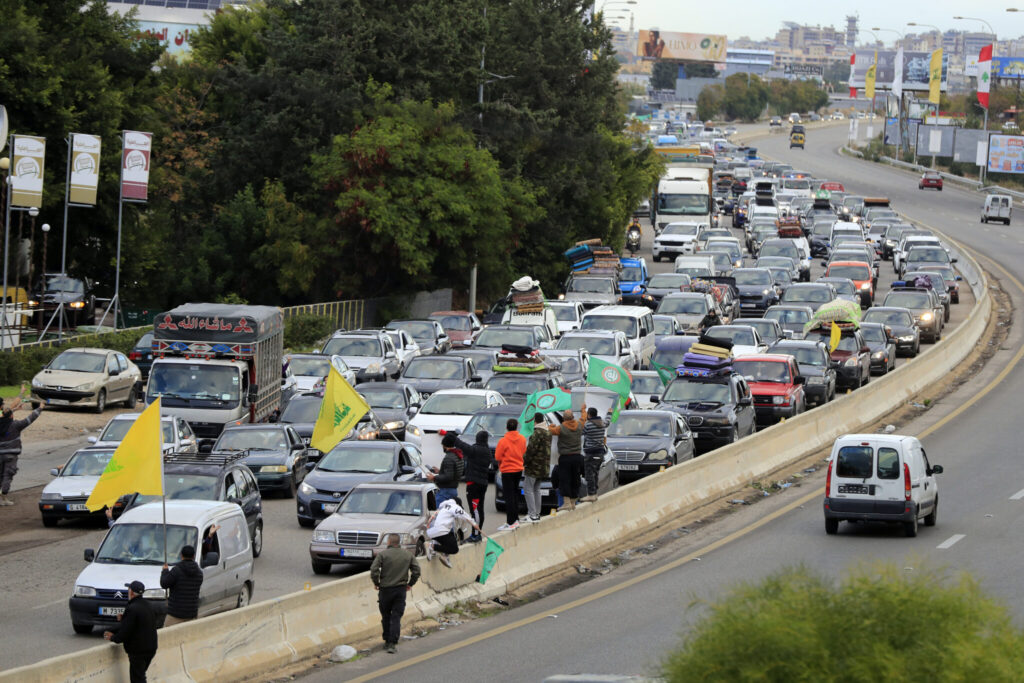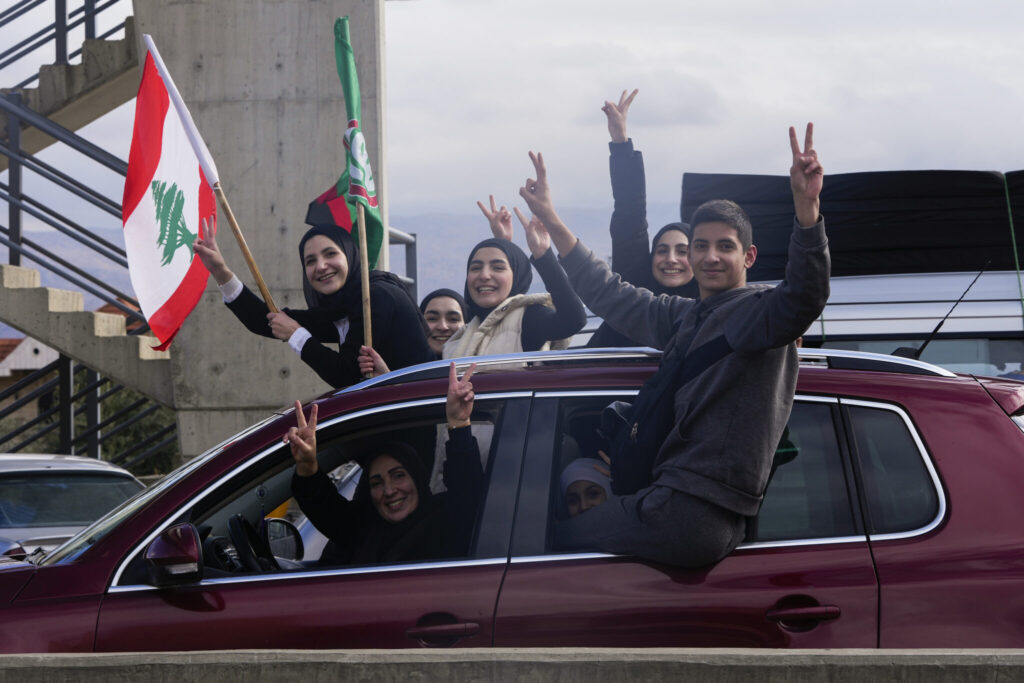Israel-Hezbollah ceasefire/ Lebanon recovery/ displaced Lebanese return/ humanitarian aid Lebanon/ U.S.-brokered truce/ BEIRUT/ Newslooks/ J. Mansour/ Morning Edition/ The long-awaited ceasefire between Israel and Hezbollah began Wednesday, bringing relief after 14 months of conflict. Displaced residents of southern Lebanon started returning home despite Israeli warnings to avoid the region. While the truce offers hope, humanitarian challenges remain with over a million people displaced and significant destruction across Lebanon. Aid groups have urged swift action to address the country’s recovery.

Key Takeaways from the Israel-Hezbollah Ceasefire
Quick Looks
- Ceasefire Details: Agreement includes a two-month halt in hostilities, Hezbollah’s withdrawal from southern Lebanon, and Israeli troops returning to their border.
- Humanitarian Crisis: 1.2 million displaced people in Lebanon and extensive infrastructure damage across the country.
- Mixed Reactions: Some residents cautiously returning home, while Israeli military advises against it.
Displaced Lebanese Return Home as Ceasefire Holds: Relief & Challenges
Deep Look
Ceasefire Sparks Relief and Cautious Optimism
After more than a year of conflict between Israel and Hezbollah, a U.S.-brokered ceasefire went into effect early Wednesday. This marks a significant step toward stabilizing the region following months of escalating violence. The agreement, which mandates a two-month cessation of hostilities, requires Hezbollah to pull its forces north of the Litani River while Israeli troops withdraw to their border.
An international monitoring panel led by the U.S. will oversee compliance, supported by U.N. peacekeepers and additional Lebanese troops deployed to southern Lebanon.
Return of Displaced People
Despite Israeli military warnings, thousands of displaced Lebanese are returning to their homes in southern Lebanon. Videos shared on social media showed cars piled with belongings heading toward Tyre and nearby villages.
Ahmad Husseini, a returning resident, called the moment “indescribable,” highlighting both relief and uncertainty. However, the Lebanese military has advised residents to avoid frontline towns where Israeli troops remain stationed.
Humanitarian and Economic Challenges
The war’s toll on Lebanon has been devastating:
- Over 1.2 million displaced.
- 100,000 homes partially or fully destroyed.
- Widespread damage to roads, schools, and hospitals.
Aid organizations, including Mercy Corps and the Norwegian Refugee Council, warn that rebuilding will be difficult for a country already struggling economically. With half the population living below the poverty line, donors have been urged to step up support for both immediate relief and long-term recovery.
Concerns Over Compliance
Israeli Prime Minister Benjamin Netanyahu emphasized that Israel reserves the right to act if Hezbollah violates the truce. Lebanese officials, however, have rejected any clause that undermines their sovereignty.
Israel-Hezbollah Ceasefire: Key Details and Regional Impacts Explained
Israel and Hezbollah began a ceasefire Wednesday after over a year of conflict. Brokered by the U.S. and France, the deal mandates Hezbollah’s withdrawal from southern Lebanon and Israeli troops returning to their side of the border. The ceasefire offers respite to both sides but leaves unresolved the ongoing and deadlier conflict in Gaza.
Key Takeaways
Ceasefire Overview
- Duration: The deal enforces a 60-day halt in hostilities.
- Terms: Hezbollah must withdraw armed forces from southern Lebanon, while Israeli troops will retreat to their borders.
- Monitoring: A U.S.-led international panel will oversee compliance, supported by Lebanese troops and U.N. peacekeepers.
Uncertainty
- Israeli Demands: Israel reserves the right to act if Hezbollah violates the agreement.
- Hezbollah’s Stance: The group supports the deal but awaits confirmation of its terms, particularly regarding sovereignty concerns.
Regional Impact
- The ceasefire isolates Gaza’s Hamas militants as fighting there continues.
- In Lebanon, Hezbollah faces criticism for the war’s toll on an already struggling economy.
Deep Look
Ceasefire Agreement: The Terms
The ceasefire between Israel and Hezbollah requires a 60-day cessation of hostilities, marking a pause in a conflict that has left more than 3,700 dead in Lebanon and over 130 dead in Israel.
Key elements of the agreement:
- Hezbollah’s Withdrawal: The group must relocate armed forces north of the Litani River.
- Israeli Troop Movement: Israeli forces will return to their side of the border.
- International Oversight: U.N. peacekeepers and additional Lebanese troops will monitor the southern region, with compliance overseen by a U.S.-led panel.
Challenges and Lingering Questions
While the agreement provides much-needed relief, its success depends on adherence by both sides. Hezbollah, which previously tied its actions to Gaza’s conflict, has backtracked on this pledge but expressed concerns about Israel’s intentions.
Mahmoud Qamati, a senior Hezbollah official, said the group supports ending the aggression but not at the expense of Lebanon’s sovereignty.
Impact on Hezbollah and Lebanon
Israel’s extensive bombing campaign targeted Hezbollah’s infrastructure, killing leader Hassan Nasrallah and several senior commanders. These setbacks have weakened Hezbollah’s standing, both militarily and politically, with many Lebanese citizens blaming the group for tying the country’s fate to the war in Gaza.
With over 1.2 million displaced and an already struggling economy, Lebanon faces significant challenges in rebuilding. Aid groups warn that the destruction of homes, roads, and infrastructure will have long-term impacts.
Gaza’s Ongoing Conflict
The truce has left Hamas increasingly isolated in Gaza, where more than 44,000 Palestinians have died in ongoing clashes. Israeli attacks continue to devastate the region, while Hamas retains leverage by holding dozens of Israeli hostages.
President Joe Biden welcomed the Israel-Hezbollah ceasefire and called for renewed international efforts to address Gaza’s crisis. However, prospects for a similar agreement in Gaza remain uncertain, as Israeli officials insist on continuing their campaign until Hamas is dismantled.
Ceasefire’s Regional Impact
While the truce has eased fears of an expanded regional war involving Iran, it does not address the ongoing conflict in Gaza, where fighting continues unabated. Hamas and international mediators have called for a similar ceasefire in Gaza, but efforts remain stalled.







